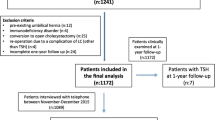Abstract
Purpose
Trocar site hernias (TSH) at the umbilical site following laparoscopic cholecystectomy forms the majority of the studies about TSH and there is a missing data in literature about lateral sided TSH. We aimed to evaluate the incidence and factors affecting lateral sided TSH occurrence following laparoscopic abdominal wall hernia repair (LAHR).
Methods
Patients who underwent LAHR between March 2013 and 2015 were included in the study. Open approach with blunt dissection for optical trocar insertion and z-shaped suture for closure were used in 22 cases initially (Group 1). Sharp dissection and continuous suture for closure were used for the rest of the patients (Group 2).
Results
285 patients—237 females (83.2%) and 48 males (16.8%)—with a mean age of 50.14 ± 12.03 were included in the study. Most of the patients were overweight or obese and mean BMI was 29.25 ± 5.04 kg/m2. BMI was significantly higher in patients with TSH (p:0.025) and TSH occurrence is significantly higher in Group 1 patients (p < 0.001).
Conclusions
Trocar insertion and closure technique have a major role in lateral sided TSH occurrence. Trying to avoid blunt dissection during trocar insertion, closure of trocar site with continuous suture and enlargement of skin incision to provide good view decreases lateral sided TSH occurrence. In addition, increase at the level of BMI has increased the probability of TSH occurrence and further studies are needed to evaluate efficiency of prophylactic prosthetic closure for obese patients.

Similar content being viewed by others
References
Boldo E, Perez de Lucia G, Aracil JP, Martin F, Escrig J, Martinez D et al (2007) Trocar site hernia after laparoscopic ventral hernia repair. Surg Endosc 21:798–800. https://doi.org/10.1007/s00464-006-9015-9
Lowry PS, Moon TD, D’Alessandro A, Nakada SY (2003) Symptomatic port-site hernia associated with a non-bladed trocar after laparoscopic live-donor nephrectomy. J Endourol 17:493–494. https://doi.org/10.1089/089277903769013649
Moran DC, Kavanagh DO, Sahebally S, Neary PC (2012) Incidence of early symptomatic port-site hernia: a case series from a department where laparoscopy is the preferred surgical approach. Ir J Med Sci 181:463–466. https://doi.org/10.1007/s11845-011-0799-9
Erdas E, Dazzi C, Secchi F, Aresu S, Pitzalis A, Barbarossa M et al (2012) Incidence and risk factors for trocar site hernia following laparoscopic cholecystectomy: a long-term follow-up study. Hernia 16:431–437. https://doi.org/10.1007/s10029-012-0929-y
Comajuncosas J, Hermoso J, Gris P, Jimeno J, Orbeal R, Vallverdu H et al (2014) Risk factors for umbilical trocar site incisional hernia in laparoscopic cholecystectomy: a prospective 3-year follow-up study. Am J Surg 207:1–6. https://doi.org/10.1016/j.amjsurg.2013.05.010
Armananzas L, Ruiz-Tovar J, Arroyo A, Garcia-Peche P, Armananzas E, Diez M et al (2014) Prophylactic mesh vs suture in the closure of the umbilical trocar site after laparoscopic cholecystectomy in high-risk patients for incisional hernia. A randomized clinical trial. J Am Coll Surg 218:960–968. https://doi.org/10.1016/j.jamcollsurg.2014.01.049
Chatzimavroudis G, Papaziogas B, Galanis I, Koutelidakis I, Atmatzidis S, Evangelatos P et al (2017) Trocar site hernia following laparoscopic cholecystectomy: a 10-year single center experience. Hernia 21:925–932. https://doi.org/10.1007/s10029-017-1699-3
Helgstrand F, Rosenberg J, Bisgaard T (2011) Trocar site hernia after laparoscopic surgery: a qualitative systematic review. Hernia 15:113–121. https://doi.org/10.1007/s10029-010-0757-x
Muysoms FE, Antoniou SA, Bury K, Campanelli G, Conze J, Cuccurullo D et al (2015) European Hernia Society guidelines on the closure of the abdominal wall incisions. Hernia 19:1–24. https://doi.org/10.1007/s10029-014-1342-5
Hernandez-Granados P, Lopez-Cano M, Morales-Conde S, Muysoms F, Garcia-Alamino J, Pereira-Rodriguez JA (2018) Incisional hernia prevention and use of mesh. A narrative review. Cir Esp 96:76–87. https://doi.org/10.1016/j.ciresp.2018.01.003
Sikar HE, Çetin K, Eyvaz K, Kaptanoglu L, Küçük HF (2017) Laparoscopic repair of large suprapubic hernias. Videosurg Miniinvasive Tech 12:245–250. https://doi.org/10.5114/wiitm.2017.68794
Hamood MA, Mishra RK (2009) Different port closure techniques in laparoscopy surgery. World J Laparosc Surg 2:29–38
Author information
Authors and Affiliations
Corresponding author
Ethics declarations
Conflict of interest
All Authors declare that they have no conflict of interest.
Ethical approval
The study was approved by Dr. Lutfi Kirdar Kartal Research and Education Hospital Ethics Committee with the registration number of 5141275.
Human and animal rights
Authors declared that the research was conducted according to the principles of the World Medical Association Declaration of Helsinki “Ethical Principles for Medical Research Involving Human Subjects”.
Informed consent
Patients were informed in detail and informed consent was obtained from the patients to use the data.
Rights and permissions
About this article
Cite this article
Sikar, H.E., Çetin, K., Eyvaz, K. et al. Lateral sided trocar site hernia following laparoscopic hernia repair: results of a long-term follow-up. Hernia 23, 101–106 (2019). https://doi.org/10.1007/s10029-018-1864-3
Received:
Accepted:
Published:
Issue Date:
DOI: https://doi.org/10.1007/s10029-018-1864-3




